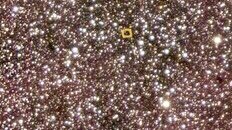SLD
Contributor
Here’s a blow up of a picture of a region in the plane of the Milky Way in Cygnus, so not the center of the galaxy.

unfortunately I can’t seem to make it bigger. Just looks like the crop of it. Hmm.
I’ve circled one. What’s its magnitude? I once read that we can’t likely detect stars beyond mag 27 or so. Not sure. Certainly none of these stars are on a star map. But maybe some of the surveys have picked these up, like Hipparchus or Gaia or Sloan, and have analyzed them all.
also why is the sky dark here? If I look at this area of the sky, which is small, I see only darkness at night. But it looks like greater than 50% of the area is covered ina star. But maybe that’s because of pixels blooming? Still there are billions of stars in this picture it seems.

unfortunately I can’t seem to make it bigger. Just looks like the crop of it. Hmm.
I’ve circled one. What’s its magnitude? I once read that we can’t likely detect stars beyond mag 27 or so. Not sure. Certainly none of these stars are on a star map. But maybe some of the surveys have picked these up, like Hipparchus or Gaia or Sloan, and have analyzed them all.
also why is the sky dark here? If I look at this area of the sky, which is small, I see only darkness at night. But it looks like greater than 50% of the area is covered ina star. But maybe that’s because of pixels blooming? Still there are billions of stars in this picture it seems.

